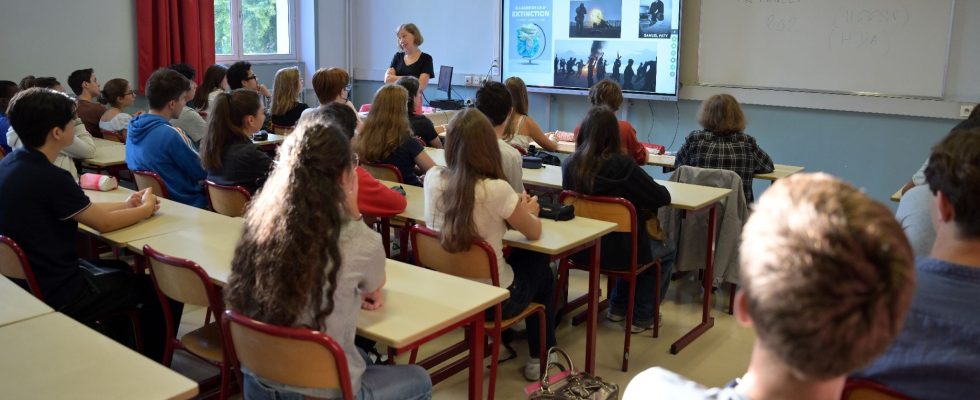Since the high school and baccalaureate reform in 2019, young girls are increasingly turning away from mathematics. At least that’s what has emerged from numerous articles or columns in recent months. But, according to the statistics taken from a survey by the Directorate of Evaluation, Foresight and Performance (Depp) of the Ministry of National Education, the results would be much more nuanced. Based on this new data, the thinkers of the reform, put in place by former minister Jean-Michel Blanquer, are breaking their silence. “In this debate, many people, through ignorance or activism, have turned their backs on rationality, objective debate and sincerity,” denounces Charles Torossian, author with Cédric Villani of a report on the teaching of mathematics in France, in 2018. This former inspector general of national education developed with the main architect of the new baccalaureate, Pierre Mathiot, a very detailed note in which he reviews certain preconceived ideas.
The authors decide not to concentrate their analysis only on mathematics, but on all scientific disciplines. In their text, which L’Express was able to consult, they recall that at the start of the 2023 school year, the triplet of specialties math, physics-chemistry and life and earth sciences (equivalent to the old bac S) was chosen in first grade by 89,000 students, including 38,000 boys and 51,000 girls. The latter, who represent 57.3% of the workforce, are therefore the majority! However, “to make people believe that scientific profiles can be summed up in this triplet is nonsense since the variety of choices has exploded”, insists Charles Torossian who counts 43 mainly scientific combinations possible in the second year of high school, i.e. – say with at least two scientific subjects in three specialties. “We have gone from an imposed first S to an assumed freedom of choice of different disciplines,” he continues.
Other information taken from the Depp study and which goes against certain preconceived ideas: mathematics today represents the second specialty education most chosen by girls (33%), just after economics and social (37%). Since 2021, we have noted a strong growth in numbers for the maths specialty among girls, with 14,000 more choosing it. In the final year of high school, students also have the opportunity to further strengthen their expertise by taking the Expert Maths option in addition to this maths specialty. Which represents 9 hours of mathematics per week. Of the total 60,000 students who choose this very advanced course, there are 20,000 girls, or a third of the student body.
Disappointment ? “No because in 2021 there were only 15,000 who opted for expert maths so we can talk about progress. And, in terms of volume, we have never had so many girls so well trained in mathematics,” replies Charles Torossian.
“Breaking the myth of the medical elite among girls”
According to National Education statistics, 203,000 high school students chose a predominantly scientific triplet (that is to say with two scientific specialty courses), including 91,200 girls (45% of students) and 112,000 boys ( 55%). Then, in higher education, statistics show an under-representation of young women in scientific studies, but the gap is tending to narrow (a little). According to the “Statistical Benchmarks and References 2023” survey, more than two out of five scientific training students are women (which represents +2.5 points in ten years).
Very present in health training at universities (66.5%), they remain in the minority in preparatory classes for major scientific schools, in engineering schools outside universities and even more in university institutes of technology (IUT) and senior technician sections (STS). “It seems important to us to break a little the myth of the medical elite and to show other paths to development linked to the professions of tomorrow. We will need women scientists in the context of reindustrialization, revitalization , ecological or digital transition issues”, insists the Ministry of National Education.
The question of information and orientation appears more essential than ever. For it to truly bear fruit, the reform must be managed as close as possible to the field. “It’s up to establishments to advise, inform and enlighten young girls, even if it means developing strategies and giving themselves quantified objectives to get them to turn more towards scientific paths,” explains Minister Nicole Belloubet’s entourage. .
And Charles Torossian draws attention to another problem that is rarely addressed: the over-representation of boys in mathematics in first grade. “We always highlight the deficit of girls but the fact that 75% of boys in general and technological 1st grades feel obliged to take this specialty education is quite revealing of the persistence of stereotypes,” he believes. According to experts, many parents tend to push their sons towards specialized mathematics education even if the latter only has a low level in second grade. Conversely, a lack of self-confidence would divert too many girls, even those with strong potential, from science subjects.
Note that the latter present much more “mixed” profiles than the boys, not hesitating to combine teaching of scientific specialties and history-geography, economic and social sciences, humanities, literature, philosophy, or even languages, literatures and cultures foreign… Alas, higher education does not always offer diplomas corresponding to these specific profiles. “It is necessary for licenses to adapt to better accommodate these new mixed profiles which will be essential for certain professions of the future,” insists Charles Torossian.
.
